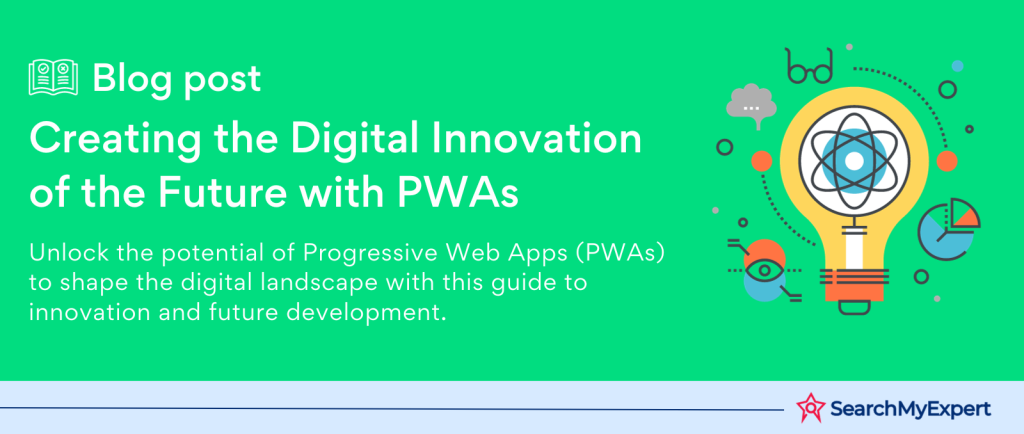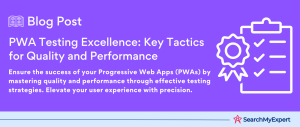The Future of Progressive Web Apps
Progressive Web Apps (PWAs) are more than just a tech buzzword; they represent a seismic shift in the digital world. PWAs blend the best of web and mobile apps, redefining user experiences with their core functionalities. So, what makes PWAs stand out?
- Seamless Installation:
Unlike traditional apps, PWAs don’t demand a visit to an app store. They can be added directly from a browser, offering a hassle-free experience. - Offline Capability:
PWAs work offline or on low-quality networks, ensuring uninterrupted access. - Performance:
They load faster and are more efficient, thanks to service workers. - User Engagement:
Features like push notifications keep users engaged. - Cross-Platform:
Built with common web technologies, PWAs are universally compatible.
The surge in PWA popularity is undeniable. They’re poised to disrupt traditional app development, offering an accessible, efficient alternative. They address the challenges of device compatibility and update issues that plague conventional apps. Businesses and developers are increasingly turning to PWAs to engage users and streamline experiences.
This outline aims to dive deep into the world of PWAs. We’ll explore their benefits, the technology powering them, real-world applications, and the challenges they face. Our journey through this guide will help you understand why PWAs aren’t just a fleeting trend, but a cornerstone of future app development.
Current Landscape of Progressive Web Apps (PWAs)
The landscape of Progressive Web Apps (PWAs) is as dynamic as it is promising. Here, we delve into the current state of PWA technology, its market adoption, user engagement, developer trends, and the challenges it faces.
Market Adoption: A Rising Tide
The adoption of PWAs is surging across industries. Businesses, from small startups to tech giants, are embracing PWAs for their versatility and cost-effectiveness.
- Retail and E-commerce:
Big names like Alibaba and Flipkart have reported significant increases in conversion rates after adopting PWAs. - Media and Publishing:
The Washington Post and Forbes are prime examples of media outlets leveraging PWAs for faster load times and improved user engagement.
User Engagement: Redefining Interaction
PWAs have revolutionized user interaction with their app-like experience without the need for an app store download.
- Push Notifications:
This feature has been a game-changer, leading to higher engagement rates. - Offline Accessibility: Users appreciate the uninterrupted access, a boon, especially in regions with spotty internet.
Developer Trends: Shifting Paradigms
Developers are increasingly favoring PWAs due to their ease of development and maintenance.
- Cross-Platform Development:
PWAs eliminate the need for multiple versions of an app for different platforms. - Updated Web Standards: Technologies like Service Workers and App Manifests are making PWAs more robust and reliable.
Challenges and Limitations
Despite the advantages, PWAs face their own set of challenges.
- Hardware Integration: Limited access to certain device functionalities compared to native apps.
- SEO Optimization:
Ensuring PWAs are discoverable and rank well on search engines remains a challenge. - Browser Support: While improving, inconsistencies in how different browsers handle PWAs can be a hurdle.
PWAs are carving a niche in the digital landscape, driven by their ability to offer a high-quality user experience with lower development costs. As technology evolves, so do the opportunities and challenges for PWAs. Understanding these dynamics is crucial for anyone looking to make the most of this transformative technology.
Emerging Technologies and Trends Influencing Progressive Web Apps
Progressive Web Apps (PWAs) are at the forefront of embracing new technologies. Let’s explore how these advancements are propelling PWAs into the future:
Artificial Intelligence (AI) and Machine Learning (ML)
- Personalization:
AI tailors content to individual preferences, creating a unique user experience. - Chatbots: They provide interactive support, revolutionizing customer service.
- Predictive Analytics:
Enhancing user experience by anticipating user needs and behavior.
Augmented Reality (AR) and Virtual Reality (VR) Integration
- Immersive Experiences: AR/VR takes user engagement to new heights, especially in retail and education.
- Enhanced Interaction:
These technologies bring a new dimension to user interaction within PWAs.
Enhanced Offline Capabilities
- Reliable Functionality:
Users can access key features even without internet connectivity. - Data Accessibility:
PWAs are becoming more efficient in data storage and retrieval, making them highly reliable.
Push Notifications and Webhooks
- Constant Engagement:
Push notifications keep users informed and engaged, enhancing the overall experience. - Real-Time Updates:
Webhooks enable PWAs to interact seamlessly with external services, ensuring up-to-date information.
Blockchain Technology
- Secure Transactions: Blockchain brings unparalleled security to transactions in PWAs.
- Decentralized Data Storage: Enhances data integrity and security, crucial for sensitive information.
As these technologies evolve, PWAs are set to become more intuitive, interactive, and indispensable. From AI’s smart personalization to blockchain’s security, the future of PWAs is bright and boundless. These advancements not only improve the user experience but also open up new avenues for application development and digital interaction.
Impact of Emerging Technologies on User Experience in Progressive Web Apps
The infusion of emerging technologies into Progressive Web Apps (PWAs) is set to revolutionize user experience. Let’s delve into how these advancements will enhance PWAs:
More Personalized and Engaging
- AI and ML Integration: Tailors content and recommendations, creating a deeply personal and relevant user experience.
- Push Notifications:
Keeps users engaged with timely and relevant updates.
More Interactive and Immersive
- AR and VR Technologies:
Transform the app into a highly interactive and engaging platform. - Chatbots and Assistive Interfaces:
Make interactions more intuitive and user-friendly.
More Accessible and Reliable
- Enhanced Offline Capabilities:
Ensures accessibility and reliability, even in low connectivity areas. - Optimized Performance:
Faster load times and smoother interactions enhance overall accessibility.
More Secure and Transparent
- Blockchain Integration:
Offers unparalleled security and transparency, particularly in transactions and data management. - Decentralized Data Handling: Ensures user data is handled securely and transparently.
The incorporation of these technologies into PWAs represents a giant leap in how users interact with applications. Personalization and engagement reach new heights with AI and ML, while AR and VR provide immersive experiences. Enhanced offline capabilities and optimized performance ensure reliability and accessibility. Finally, blockchain technology brings a new level of security and transparency, making PWAs not just more user-friendly but also more trustworthy.
Opportunities for Businesses with Progressive Web Apps
Progressive Web Apps (PWAs) open a realm of opportunities for businesses. Let’s explore the key benefits they offer:
Increased Reach and Engagement with Mobile Users
- Cross-Platform Accessibility:
PWAs work across various devices, broadening the potential user base. - Enhanced User Engagement: Features like push notifications increase interaction and time spent on the app.
Improved Conversion Rates and Sales
- Streamlined User Experience:
The app-like interface and faster load times of PWAs enhance user satisfaction, leading to higher conversion rates. - Offline Capabilities: Allow users to browse and engage with the app even without an internet connection, potentially increasing sales.
Reduced Development and Maintenance Costs
- Single Development Effort:
PWAs eliminate the need to develop separate apps for different platforms, significantly reducing development costs. - Easier Updates and Maintenance: Updates are simpler and more cost-effective, as they are done directly on the web app.
Enhanced Brand Loyalty and Customer Satisfaction
- Personalized Experiences:
AI integration enables personalized interactions, improving customer satisfaction. - Reliable and Consistent Performance:
The dependable performance of PWAs fosters trust and loyalty among users.
PWAs are not just a technological advancement; they’re a strategic business opportunity. Their ability to reach a wider audience, improve sales, reduce costs, and enhance customer loyalty positions them as a powerful tool in the modern digital landscape.
Challenges and Considerations in Adopting Progressive Web Apps
Adopting Progressive Web Apps (PWAs) comes with its set of challenges and considerations. Businesses need to navigate these effectively for successful implementation.
Lack of Awareness and Understanding
- User Awareness: Many users are still unfamiliar with PWAs and their benefits.
- Developer Knowledge:
Developers may need training or resources to effectively build PWAs.
Technical Limitations and Compatibility Issues
- Browser Compatibility: Not all browsers support PWA features equally, which can limit functionality.
- Hardware Integration:
PWAs sometimes struggle with deep integration into device-specific hardware features.
Ensuring Offline Functionality and Data Accessibility
- Offline Challenges: Creating a robust offline experience requires careful planning and implementation.
- Data Management:
Efficient data storage and accessibility in offline mode can be complex.
Implementing Effective Marketing and User Acquisition Strategies
- Market Positioning:
PWAs need clear marketing strategies to stand out. - User Acquisition: Convincing users to switch from traditional apps to PWAs can be challenging.
Businesses must not only focus on the technical aspects of PWAs but also on educating users and developers. Overcoming technical limitations, ensuring effective offline functionality, and implementing strong marketing strategies are crucial for the successful adoption of PWAs.
Embracing the Future with Progressive Web Apps
As we wrap up our exploration of Progressive Web Apps (PWAs), let’s revisit the key insights:
- Redefining User Experience: PWAs combine the best of web and mobile apps, offering seamless installation, offline capabilities, and enhanced performance.
- Current Landscape:
Their growing adoption across industries, coupled with high user engagement and developer interest, underscores their rising significance. - Emerging Technologies:
Integration of AI, AR/VR, blockchain, and other technologies is set to make PWAs more personalized, immersive, and secure. - Impact on Business:
PWAs present opportunities for increased reach, improved conversion rates, reduced costs, and enhanced customer loyalty. - Challenges to Tackle:
Awareness, technical limitations, offline functionality, and strategic marketing are areas businesses need to address.
The future of PWAs is not just promising; it’s transformative. They are poised to revolutionize the web app landscape with their advanced capabilities and broad-reaching benefits. For businesses, the call to action is clear: explore and embrace PWAs as a key component of your digital strategy. The time to act is now, to stay ahead in the digital race and leverage the full potential of Progressive Web Apps.
Conclusion
Progressive Web Apps (PWAs) stand at the forefront of digital innovation, blending the best of web and mobile app features. Their rise in popularity, fueled by advancements in AI, AR/VR, and blockchain, promises a more personalized, immersive, and secure web experience. While challenges exist, the potential for increased engagement, sales, and cost-effectiveness make PWAs an invaluable asset for businesses. Embracing PWAs is not just a step towards modernization; it’s a leap into the future of digital interaction and customer engagement.
Unleash the power of modern web with our
Progressive Web App Company.
Further Reading
Table of Contents
Toggle






